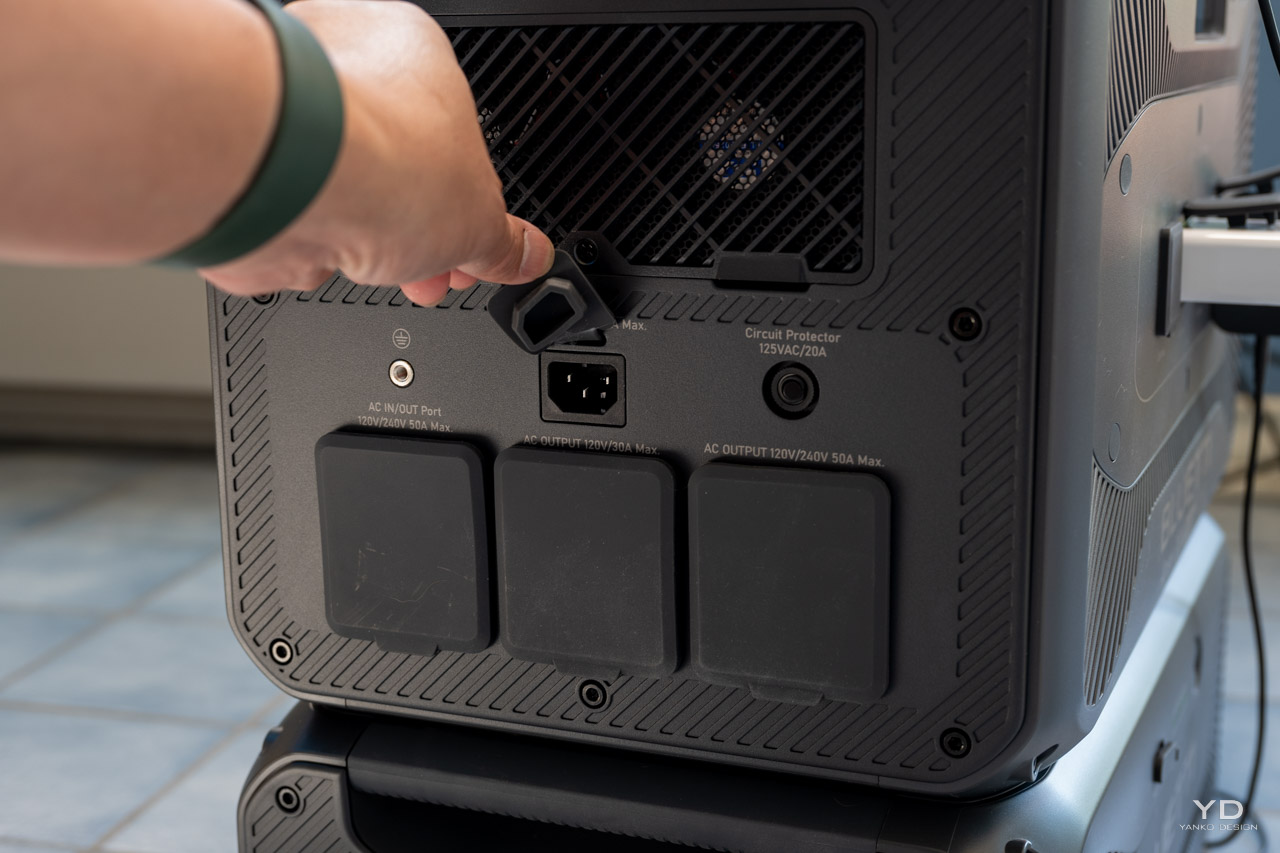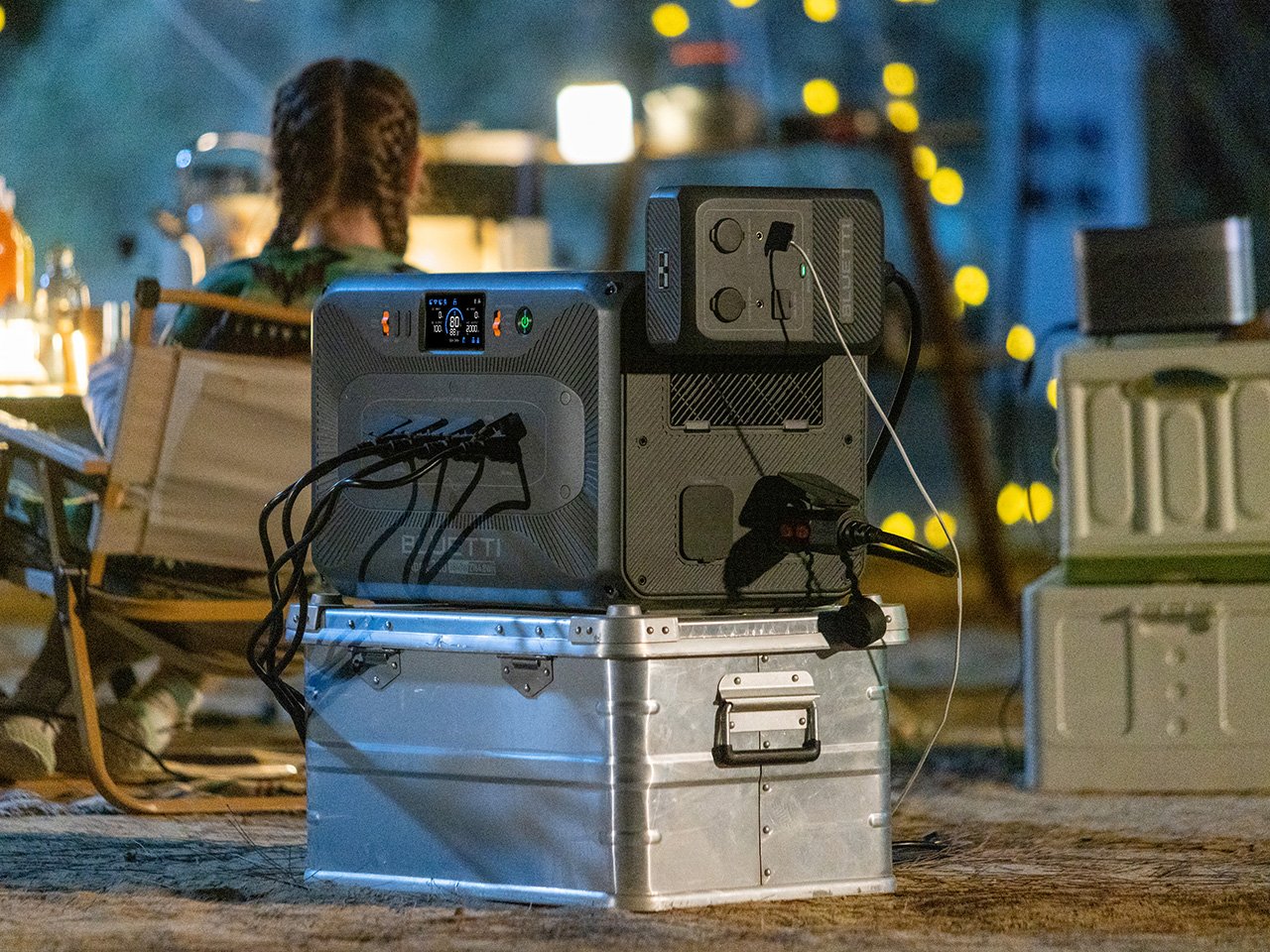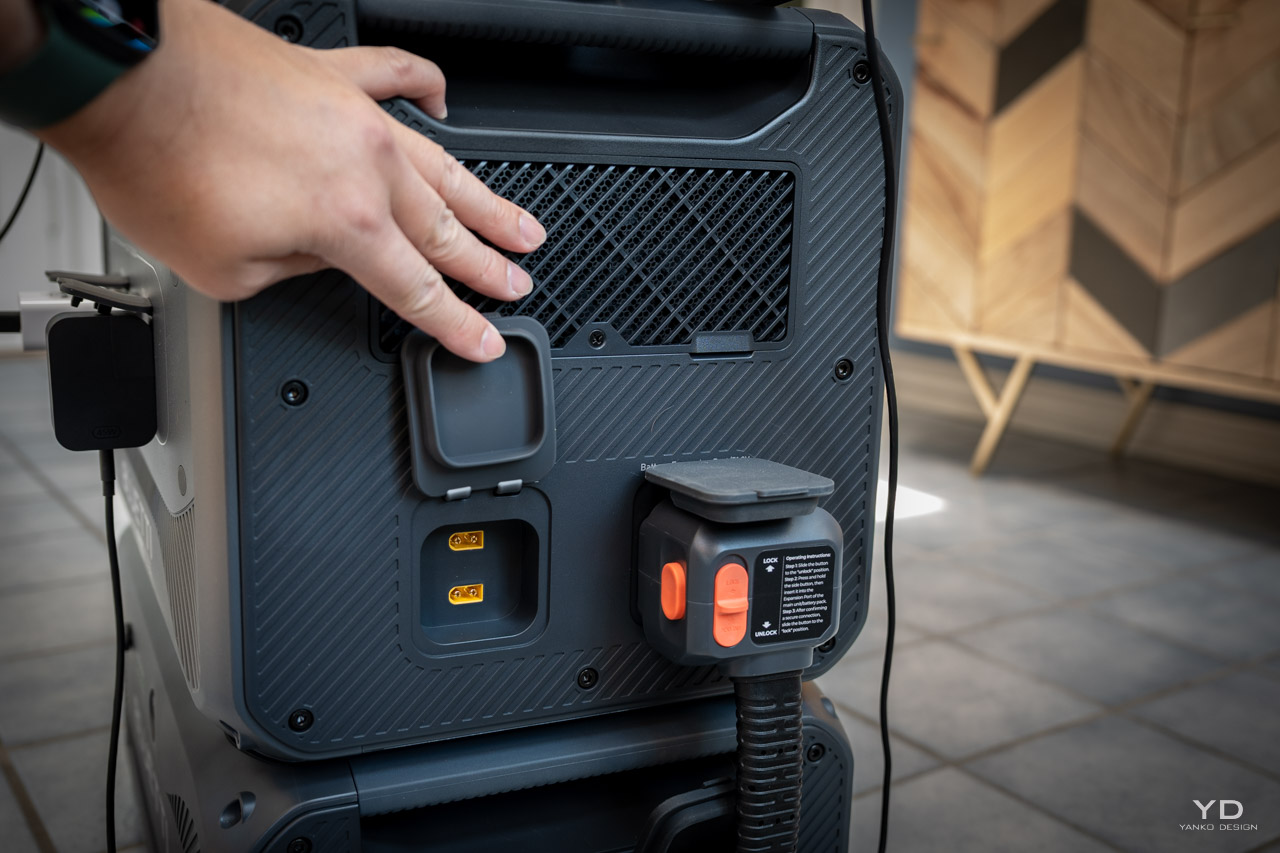The BLUETTI Apex 300 isn’t meant to sit idle between emergencies. It fits into daily routines, powering everyday essentials without rewiring or installing. This review focuses on how it performs with real products in familiar settings. That includes household appliances during outages, coolers and fans during weekend camping, and portable gear on long tournament days. There are no solar arrays or panel integrations. Just plug and use.
PROS:
- Exceptional 6,000+ charge cycle lifespan offers 17 years of reliable operation, doubling industry standards.
- Impressive 3,840W output and 120/240V dual voltages for handling multiple high-demand appliances simultaneously without faltering.
- Efficient 20W AC idle drain extends runtime significantly during extended outages.
- Modular design with B300K expansion battery allows customized scaling without replacing initial investment.
- Compatible with 120/240V gas generator (11,520W in parallel connection) for extended power outage.
- Massive 6,400W solar input capacity enables rapid renewable charging with potential two-year payback and over 30kW of solar input for whole-home backup.
- Low upfront cost at just $0.36/Wh for those who need serious power.
CONS:
- 2.7kW capacity may limit portability, making it less suitable for those with lower power needs.
- Lacks dedicated DC ports (requires the optional Hub D1 accessory, which offers 700W DC output), but this trade-off helps keep the price more affordable.
Designer: BLUETTI
Click Here to Buy Now: $1199 $2399 ($1200 off). Hurry, deal ends soon!
With 2,764.8Wh of capacity and 3,840W of output, the Apex 300 handles a refrigerator in the kitchen, a portable AC near the tent, or a Typhur air fryer at the courts. It doesn’t need a permanent location. You can roll it into the laundry room to run a washer or dryer in an emergency, or drop it under a canopy to keep drinks cold and phones charged.
While the unit supports advanced configurations through expansion hubs and bypass systems, those features are outside the scope of this review. The goal here is practical performance with common products, powered directly from the main unit or its optional DC hub.
From prolonged blackout prep to match-day support, the Apex 300 demonstrates the potential of a high-capacity portable power station, especially when paired with a fuel generator, all without leaving the average user behind.
Design & Ergonomics
The Apex 300 has a compact, squared chassis with reinforced edges and no cosmetic finishes. It weighs just under 84 pounds. While the mass is noticeable, it’s not difficult to move. A recessed top handle sits flush and centered for balance. Two side handles are molded into the body, one on each side. This lets you lift using proper form without needing to twist or overcompensate. The handle spacing and weight distribution make it possible to load in and out of a trunk or reposition in tight spaces without tipping. The casing is matte composite. No gloss, no soft-touch. It’s built to resist fire and impact, with corner protection and stiff panels that don’t flex. There’s no padding, no shiny accents. This is a working product for flinching in harsh environments or heavy-duty use, not something designed for display.
The front panel consolidates all standard AC outputs. What stands out most on the front panel is the 120/240V voltage selector—a rare feature in this category. With a simple toggle, the Apex 300 can switch between standard 120V and powerful 240V split-phase output, all from a single unit. There’s no need for dual machines, external inverters, or bulky adapters. Just press the 240V button, and the side port activates 240V output while the front-facing 120V outlets remain fully functional. Even better, it supports simultaneous charging and discharging in both voltage modes, making it one of the most flexible power solutions out there. There are four 120V/20A outlets arranged in a horizontal line. Above the sockets, the integrated digital display shows live system status. Remaining battery is presented both numerically and visually via a segmented arc. Directly below, the estimated charge or runtime is shown in hours and minutes. Along the sides of the screen, AC and DC power input and output are broken down in watts. System icons flank the upper corners, indicating ECO mode, connectivity status, and fan operation. Alerts appear in the lower corners with a flashing indicator. The display is not touch-sensitive, and there are no layered menus. Everything is presented in one view. Visibility holds up in bright conditions without overwhelming in low light.
The left side houses dual cooling vents and serves as a passive intake for airflow. The 120/240V 50A AC input/output port and high-capacity outputs, including the 120V/30A TT-30R and 120V/240V 50A NEMA L14-50R outlets, are well located. The 50A AC input also supports charging from a 120/240V gas generator, making it ideal for extended power outages. These ports are clearly labeled. Rubberized flaps protect these areas. A grounding screw is located near the input ports. Vents positioned near these ports help manage thermal output. During charging or peak load, the integrated fans remain active but quiet, operating at around 40 to 50 dB under standard use.
The right side is used for expansion. This is where the Apex 300 connects to the B300K battery via a shorter, more manageable cable. Compared to the previous longer cable version, this design saves space and improves efficiency with a more compact setup. That link locks securely and routes downward. A sealed accessory port sits next to the connector. The upper portion includes additional ventilation similar to the left side. There’s no interference between ports, and stacking doesn’t block airflow.
The B300K adds 2764.8Wh to the total system capacity. At nearly 79 pounds, it’s only slightly lighter than the main unit. Each side of the B300K includes a top-mounted handle for lifting. When docked, the battery aligns flush with the Apex 300 and maintains overall balance. Up to four B300K modules can be stacked, but extra securing is recommended when exceeding two levels.
Cooling is managed through a dual fan system located behind the side grills. These stay active during higher loads or rapid charging. Fan noise remains even, with no distracting pitch or rattle. This makes the Apex 300 usable near sleeping areas or indoor workspaces without disturbance.
DC output is delivered through the optional Hub D1. This hub adds USB-C, USB-A, DC5521, a 12V auto socket, and a 50A Anderson connector standing out as a high-power DC port designed for safety and stability. It attaches vertically and doesn’t expand the unit’s footprint. If you rely on DC or USB-based devices, the hub becomes essential.
The Bluetti app mirrors much of what’s shown on the Apex 300’s physical display. Once paired via Wi-Fi or Bluetooth, it displays a central battery status ring with remaining percentage, real-time breakdowns of AC and DC input/output wattage, and estimated time until full charge or depletion. Users can toggle AC and DC outputs, track solar contribution, and review historical usage. The interface uses strong visual cues with all major controls accessible directly from the home screen. Charging modes, notifications, and system alerts are accessed without diving through submenus. The layout prioritizes quick access and clarity over aesthetics.
Everything about the Apex 300 centers on performance. It’s a modular, high-output power system designed for actual use, not showroom aesthetics. Whether keeping food cold during blackouts or running appliances off-grid, it stays focused on delivering energy where it’s needed most.
Performance
This review centers on standalone use without any home integration. When the power goes out, whether from weather, an accident, or a grid failure, you plug in what you need and the Apex 300 just runs. No rewiring. No fuss. All testing here used the onboard AC ports directly.
In one overnight “staged” outage, the unit powered a full-size refrigerator, router, lights, and a breathing machine. Output stayed steady, and the digital panel clearly showed remaining time and load. The app mirrored this from another room. Power usage was easy to track, and the fridge didn’t cycle off.
On a long weekend of stay-at-home glamping, the Apex 300 handled a Typhur air fryer, a drip coffee machine, and a portable AC without blinking. The 3,840W output had no problem handling the startup surge. The fans kicked on but didn’t become a distraction. Nothing tripped, nothing overheated.
On another occasion, it powered backyard lighting, a portable fridge, and charged phones during an overnight glamping setup. Later, during a neighborhood blackout caused by a downed transformer, the Apex 300 powered a microwave, a drip coffee maker, and several LED lanterns while also recharging phones and two-way radios. It helped keep things calm without dragging out a gas generator. During another outage, it kept two fans and a portable AC unit running through the night in a hot upstairs office. While I don’t rely on a CPAP device, anyone who does can rest assured knowing the Apex 300 can power one continuously without issue. The ports are spaced well enough to plug in multiple devices without overlap or cord clutter.
If your fridge runs on AC power, as most home units do, you don’t need anything extra. Just plug it into one of the four 120V outlets or the larger NEMA sockets, and it works. The Apex 300 delivers clean, reliable AC power for standard appliances. However, if you have a 12V DC fridge like those used in vans or campsites, limitations appear. The Apex 300 doesn’t have native DC output for those loads without an accessory.
Everything here was tested without tying into a breaker panel or generator loop. This is power where you need it, when the wall socket doesn’t exist. The Apex 300 isn’t just spec sheets—it held up during real blackouts, heatwaves, and extended unplugged days. It powered what mattered, and didn’t get in the way.
Emergency Runtime Scenarios
In a blackout with no charging, the Apex 300 offers 2,764.8Wh. Adding the B300K doubles that to 5,529.6Wh. A basic emergency load including a fridge, laptop, router, phone, lights, and a CPAP draws about 1,950 to 2,200Wh daily.
The Apex 300 alone powers this for roughly one day. Stretch it to 1.5 days by cutting nonessential loads. With the B300K, expect 2 to 2.5 days. Focus on the fridge and communication gear to reach 3 days.
Cycle loads instead of running everything at once. Run the fridge during the day. Charge devices one at a time. Use lights only when needed.
Sustainability
While I haven’t personally tested the Apex 300 with solar panels, the sustainability potential here deserves serious attention. The system’s solar integration capabilities transform it from the category of home battery backup to a genuine renewable energy solution with remarkable long-term value.
The Apex 300’s most impressive feature is its exceptional solar input capacity. When paired with BLUETTI’s SolarX 4K Solar Charge Controller, a single unit can process up to 6,400W of solar input. This represents a quantum leap beyond typical portable power stations that max out around 1,000-2,000W. For perspective, this means you could potentially recharge the entire system in just a few hours of good sunlight rather than waiting all day or longer.
Most foldable solar panels might have inherent limitations in efficiency and are dependent on weather conditions, which is why a high input capacity for energy storage is so crucial. The Apex 300 maximizes every minute of sunshine, capturing significantly more energy during peak daylight hours. This efficiency accelerates the system’s potential payback period to approximately two years according to BLUETTI’s calculations. Few renewable energy investments offer such a rapid return.
The Apex 300 avoids the usual tradeoff between portability and long-term value. At its core are BLUETTI’s automotive-grade LFP batteries, rated for over 6,000 charge cycles. That translates to around 17 years of daily use, nearly doubling the lifespan of many competing systems that typically last 3,000 to 4,000 cycles. This added durability cuts down on the frequency of replacements, which in turn reduces electronic waste and long-term costs. BLUETTI reinforces this commitment to longevity with rigorous validation. The larger Elite 200 V2 Solar Generator has passed 33 CNAS-certified automotive-grade tests, underscoring the brand’s approach to building quality and environmental responsibility across its ecosystem.
This solar integration capability creates genuine resilience for regions prone to extreme weather events like Texas and Florida. The system’s dual MPPT controllers enable remarkably fast charging, reaching 80% capacity in just 40 minutes under optimal conditions. When fully expanded, the Apex 300 system can scale to deliver over 11kW of output with 58kWh of storage capacity, providing enough power to maintain essential home systems for a week without grid access.
The AT1 Smart Distribution Box completes the sustainability equation by intelligently managing power flow between solar panels and the grid. This allows homeowners to create a customized, automated whole-home backup system that prioritizes renewable energy usage while maintaining grid connectivity when needed. The entire ecosystem works together through BLUETTI’s smartphone app, making sustainable energy management accessible even to those without technical expertise.
Value
The Apex 300 represents a significant investment. What truly matters isn’t only the initial cost but the long-term value proposition. This portable power station delivers exceptional returns through its versatility, durability, and advanced capabilities that go far beyond emergency backup. The system’s true value emerges when you consider how it integrates into everyday life and critical situations without compromise.
The system’s exceptional efficiency further enhances its value proposition. With remarkably low 20W AC idle drain, the Apex 300 preserves power when not actively running devices. This translates to 24 additional hours of refrigerator runtime, 2.5 times longer AC standby, and 2.5 more days of CPAP operation compared to competing systems with higher idle consumption. During extended outages, this efficiency becomes invaluable, potentially meaning the difference between maintaining power for essential devices and running out at critical moments. The 0ms UPS switching ensures absolutely seamless power transitions, protecting sensitive electronics and providing peace of mind for those relying on medical equipment.
Perhaps most impressive is how the Apex 300 scales with your needs without forcing unnecessary complexity. The base unit delivers substantial capability on its own, while the modular expansion system allows growth without replacing your initial investment. The optional Hub D1 adds comprehensive DC output options, the B300K batteries multiply capacity, and solar integration unlocks renewable energy potential. This flexibility means the system grows with your needs rather than becoming obsolete when requirements change. Few products in any category offer this combination of immediate utility, long-term durability, exceptional efficiency, and adaptable design. For anyone serious about energy independence, weather resilience, or sustainable power solutions, the Apex 300 delivers value that extends far beyond its price tag.
The Bottom Line
This review set out to evaluate the Apex 300 as a practical power solution for real-world scenarios, from blackouts to outdoor adventures. The results speak for themselves after extended testing with everyday appliances and devices. The Apex 300 delivers on its promises with exceptional performance, remarkable durability, and thoughtful design choices that prioritize user experience. Its 17 years lifespan (nearly double the industry standard), ultra-efficient 20W idle drain, and seamless expandability create a system that grows with your needs rather than becoming obsolete. While we didn’t test solar integration, the potential 6,400W solar input capacity through the SolarX 4K could transform this from merely a backup solution into a comprehensive renewable energy system with a potential two-year payback period.
Whether you’re preparing for power outages or planning off-grid adventures, the Apex 300 offers a flexible solution with support for battery, solar, and even gas input. It’s designed to handle real-world energy needs with surprising ease.
Among the available options, the one we’re reviewing, the Apex 300 + B300K expansion battery bundle, stands out because it costs just $0.36 per watt-hour, with tax and shipping already included. The offer is limited by both time and availability, with installment payments now available for added flexibility.
There are other bundles designed for different needs, so it’s worth checking which one fits your setup. The Apex 300 campaign is now live on Indiegogo until July 19.
Click Here to Buy Now: $1199 $2399 ($1200 off). Hurry, deal ends soon!

























